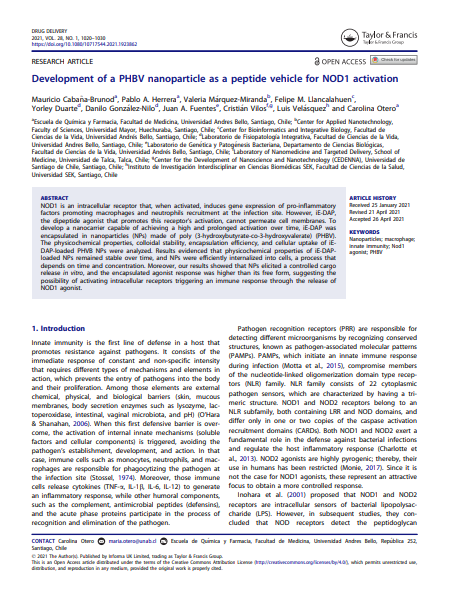Development of a PHBV nanoparticle as a peptide vehicle for NOD1 activation

Fecha
2021-06-08Autor
Cabaña-Brunod, Mauricio
Herrera, Pablo A.
Llancalahuen, Felipe M.
Duarte, Yorley
Gonzalez-Nilo, Danilo
Fuentes, Juan A.
Vilos, Cristian
Velásquez, Luis
Otero, Carolina
Marquez-Miranda, Valeria [Univ Mayor, Fac Sci, Ctr Appl Nanotechnol, Chile]
Ubicación geográfica
Notas
HERRAMIENTAS
Acceda a títulos restringidos
¿Cómo descargar?Resumen
NOD1 is an intracellular receptor that, when activated, induces gene expression of pro-inflammatory factors promoting macrophages and neutrophils recruitment at the infection site. However, iE-DAP, the dipeptide agonist that promotes this receptor's activation, cannot permeate cell membranes. To develop a nanocarrier capable of achieving a high and prolonged activation over time, iE-DAP was encapsulated in nanoparticles (NPs) made of poly (3-hydroxybutyrate-co-3-hydroxyvalerate) (PHBV). The physicochemical properties, colloidal stability, encapsulation efficiency, and cellular uptake of iE-DAP-loaded PHVB NPs were analyzed. Results evidenced that physicochemical properties of iE-DAP-loaded NPs remained stable over time, and NPs were efficiently internalized into cells, a process that depends on time and concentration. Moreover, our results showed that NPs elicited a controlled cargo release in vitro, and the encapsulated agonist response was higher than its free form, suggesting the possibility of activating intracellular receptors triggering an immune response through the release of NOD1 agonist.
URI
https://repositorio.umayor.cl/xmlui/handle/sibum/9087https://www.ncbi.nlm.nih.gov/pmc/articles/PMC8174487/pdf/IDRD_28_1923862.pdf
https://doi.org/10.1080%2F10717544.2021.1923862
https://www-tandfonline-com.bibliotecadigital.umayor.cl:2443/doi/epdf/10.1080/10717544.2021.1923862?needAccess=true
Coleccion/es a la/s que pertenece:
Si usted es autor(a) de este documento y NO desea que su publicación tenga acceso público en este repositorio, por favor complete el formulario aquí.